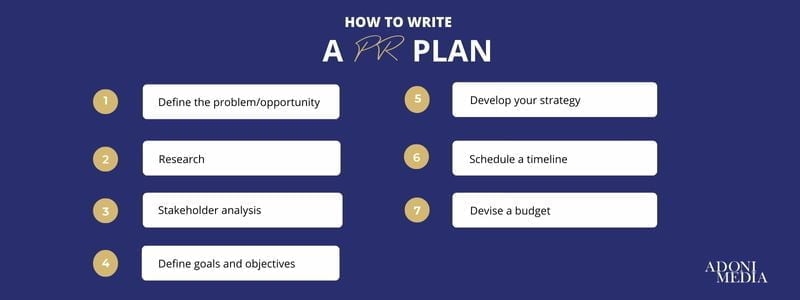How to write a plan for a PR campaign
Planning a PR campaign takes time and effort but the more work and research you put into a PR plan, the higher the chance of success.
To write a plan for a PR campaign, you need to consider target audiences, key messages, and media outlets you want to reach as part of your communications activity.
To design and deliver a successful PR campaign, it is essential to have a comprehensive and well-researched plan that your business can follow, measure, and improve on.

Here is our go-to list to ensure you plan your PR activity in the best way possible:
Step 1: Define the problem/opportunity
For a campaign to be successful, it is essential to understand why the campaign is needed. A clearly outlined problem/opportunity will guide you on how to design and deliver a successful media plan and structure your PR campaign.
Typically, PR campaigns focus on raising awareness, attitudes, knowledge, behaviour, and opinion. For a campaign to be successful, you must know the purpose of your campaign and what the desired outcome is.
Step 2: Research
Research will help guide your strategy. Research can include previous media coverage, competitor analysis, audience sentiments, and relevant industry reports.
In some cases, this may also include conducting primary research, such as focus groups or surveys, the findings of which can be used for PR activity.
Step 3: Stakeholder Analysis
A stakeholder analysis will support you in identifying the target audience for your PR campaign. Through using analysis tools such as a Power Interest Matrix, you can prioritise and manage stakeholders.
Generally, your target audience will be the stakeholders with the highest power and interest. And typically, they’ll have the most potential value. It is not enough to identify them, you also need to understand them and know how to communicate in a way that is relevant to, and interests, them.
Creating Target Market Profiles will help you understand who your target audience is, what they care about, and where they can be found. Their demographics, location, and psychographics can also help you to shape your strategy and overall campaign.
Step 4: Define Goals and Objectives
The next step is to establish goals and objectives for the campaign. Although often used synonymously in a PR campaign, goals and objectives have different purposes.
Goal:
The goal of your campaign should speak to its purpose – ask yourself “why is this campaign needed and what will it achieve?”.
Objectives:
Your objectives outline how the goal will be achieved. They must be SMART (Specific, Measurable, Attainable, Relevant, Time-bound). Your objectives will provide you with a baseline benchmark to measure the success of your campaign and your progress throughout.
Step 5: Strategy
Key messaging
Developing strategic and targeted key messages is essential to achieving the goals and objectives of your campaign. Typically, campaigns have one primary key message with up to five secondary key messages.
Adoni Media Communications Director Clare Christensen said, “I recommended businesses develop three strong key messages to support their PR campaign. This allows all communication to be clear, concise, and compelling, and importantly consistent across all channels”.
Supporting tactics
How will the key messages be delivered to the target audience? Increasingly, PR campaigns reach beyond traditional earned media and a multi-media, integrated campaign is often adopted. Common PR tactics that may support your strategy include media releases, media conferences, events, social media posts, influencer marketing, EDMs and more. The strategy must take into consideration the intended target audience, and so you should ask yourself “how does my audience engage and interact with media? What platforms are they on and why?”.
Step 6: Timeline
Create a schedule and plan how the campaign will be rolled out. Your timeline should be specific and detailed. Creating a comprehensive timeline will ensure you stay on track. Remember to consider your objectives and the time goals you have set.
Tip: When possible, tie your campaign to related events/days. This will lend relevance to your campaign which can assist with gaining media coverage.
Step 7: Budget
Finally, it is time to devise a budget that details the expected costs for your PR campaign. An adequate budget is essential to achieving optimal results. It can be beneficial to create your timeline and budget concurrently to develop a realistic plan of action with the cost of each activity.
Are you ready to take the next step and launch a PR campaign?
Do you have a new announcement or new development you would like publicity for?
Not sure where to start with PR?


